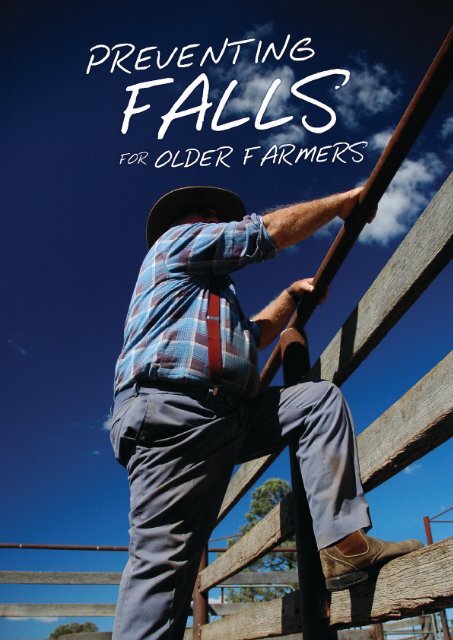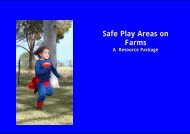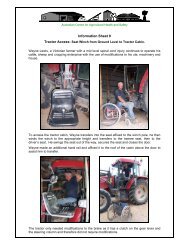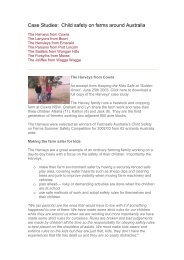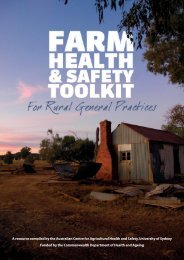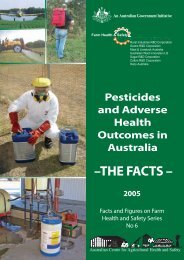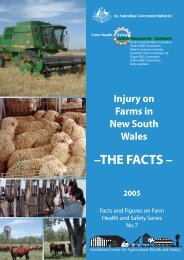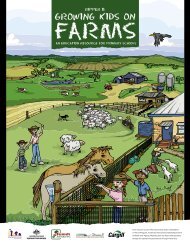Aghealth Older Farmers Falls Resource - Australian Centre for ...
Aghealth Older Farmers Falls Resource - Australian Centre for ...
Aghealth Older Farmers Falls Resource - Australian Centre for ...
You also want an ePaper? Increase the reach of your titles
YUMPU automatically turns print PDFs into web optimized ePapers that Google loves.
1. <strong>Falls</strong> Risk Checklist — Identifyingyour personal falls riskFilling out this section will help you identify any individual factors thatmay increase your risk of falls. This in<strong>for</strong>mation can then be used to takeaction to reduce those risks.• Part A you can do sitting at a table - simply tick the boxes that apply to you• Part B shows you how to do 3 simple tests of balance and strength to assessyour balance and strengthOnce you have done these you add up your score to work out your falls riskscore.Part A: Tick Questions YES NOHave you had a fall in the last year? (if YES, How many times…….)Do you have a fear of falling?Are you taking four or more prescription medicines?Are you taking any of the following — sleeping tablets, tranquilizers,antidepressants, fluid tablets or blood pressures pills?Has your GP reviewed your medicines in the last 12 months?Do you have blurred/double vision or have difficulty seeing steps,walking in dim or glary light?Have you had your eyes tested or your glasses checked in the last12 months?Do you experience dizziness, light headedness, unsteadiness,drowsiness or have difficulty thinking clearly?Do you have diabetes, arthritis, Parkinson’s disease or Osteoporosis?
Making sense of your personal risk scoreAfter looking at your falls score there are two more important things tothink about.1. If you work at heights you will be at increased risk of having a fall thatresults in severe injury or death.Farm HazardsOn your farm do youwork in areas that are1-5 m off the ground– eg trucks, headers,tractors, loading docksramps?<strong>Falls</strong> Risk Rating 0-2Normal risk of falls– attention to fallsprevention required<strong>Falls</strong> Risk Rating > 2High Risk of falls:• improve personal fallsrisk• engineer to reduce riskOn your farm do youwork in areas thatare more that 5m fromthe ground – eg silo’swindmills?<strong>Falls</strong> hazards high risk toall personsHIGH RISK: Workshould not beundertaken. All ef<strong>for</strong>t toavoid this work shouldbe taken.2. If your score was 3 or above, take this sheet with you to your GeneralPractitioner and discuss your risk of falls and ways to prevent falls.
2. My Plan to Prevent FallingPart A: Daily exercises that can help to prevent fallsPhysical activity, particularly strength and balance training can help prevent falls.These are examples of key exercises that you can do every day to help prevent fallsand reduce your risk of being injured if you do fall.Sit-to standSeated in a chair stand up slowly andhold <strong>for</strong> 5 seconds• This helps with your leg strength• You could do this at the kitchen table• Do at least 10 timesTandem walkWith one foot in front of the otherwalk along in a straight line• This exercise helps with your balance• You could do this down the hallway oralong the verandah• Look <strong>for</strong> opportunities to do this everyday (eg. every time you walk down thehallway or along the verandah)Leg extensionWhile sitting in a chair straighten oneleg at a time and hold <strong>for</strong> 5 seconds• This exercise helps with leg and anklestrength• You can add resistance to this exerciseby adding weight such as a bag of rice• Do at least 10 times each legExtra Walking: On a smooth surface use a pedometer to count your steps.Try to walk at least 10,000 steps a day. Look <strong>for</strong> ways to increase your stepseach day. For example, you could leave the bike at the shed and walk back upto the house, or walk to the front gate instead of riding or driving.
Part B: Making changes on the farm to reduce riskof fallsThere are many things in the farm workplace as well as around the house that canincrease your risk of falls and taking action to eliminate or control these factorscan prevent falls. These are a few ideas that farmers around North West NSWcame up with to reduce falls risk on their farms that may apply to you as well.Grab Rails• Look where you can put additional grab rails on trucks, tractors and headers,walkways etcSteps• Look where you can put additional steps – ie safe tractor access plat<strong>for</strong>m onmachinery• Apply non-slip tape/matting to make surfaces less slippery• Apply marking paint or tape to highlight falls risk areas – eg steps, plat<strong>for</strong>m edgesWorking at Heights• Choose ladders that are appropriate to weight• If you must work at heights, have a safety harness available <strong>for</strong> your use and useby others.Light up places to improve Visibility• Make sure lighting is good, <strong>for</strong> example around buildings where visibility may bepoor in the early morning or in the evenings.Personal Protective Features• Have available aids such as walking sticks, staffs, and sticks <strong>for</strong> walking onuneven or steep ground• Wear appropriate footwear that fits well and has grip solesAwareness/Education• Minimise clutter in workshop and keep pathways clear• Livestock handling areas pose special risk and need special attention. (See theGreat Idea Bank <strong>for</strong> ideas)• Be aware of moss, ice, and other slippery substances on the ground or floor surfaces• Be aware of your own limitations• Think and plan to prevent falls
Part C: My falls prevention plan1. Score on <strong>Falls</strong> Risk Checklist _____________2. My exercises to help protect me from falling• Sit-to-stand:• Tandem walk:• Leg extension:• Extra Walking_______ times a day_______ times a day_______ times a day_______ steps a day3. I will discuss falls risks and falls prevention with my GP(asking <strong>for</strong> a long consultation) _____________4. Our action to reduce falls in the farm workplaceReferences<strong>Australian</strong> <strong>Centre</strong> <strong>for</strong> Agricultural Health and Safety: Safety of <strong>Older</strong> <strong>Farmers</strong> Chartbookwww.aghealth.org.auAcknowledgementsThis resource has been made available through funding from the Department of Health andAgeing as part of the North West Farmsafe <strong>Falls</strong> Injury Prevention Project. The work of thesteering committee and members of the North West Farming Community who participated inthe project workshops is greatly appreciated in the development of this resource.
The GreatIdea BankGood advice fromolder farmers to reducerisk of fallingThis section of the Great Idea Bank will be expanded as moreideas are added to those provided by farmers in NSW.Send in your ideas to share with others and add to the collection.
Some Good General PrinciplesGood advice from older farmers around AustraliaMake your changes sooner rather than later!The sooner you make the job easier, the better your quality of life.Furthermore, you'll get the most from your early investment in time orresources.Steps and rails make life much easierPutting better and lower steps on trucks, machines and buildings, withstrong hand rails to grab, and help take the weight work like magic.You need to look <strong>for</strong> where you might make these changes.Most changes are not that expensiveMany of the changes need not cost the earth – and its not self-indulgentto spend a bit on yourself – you've earned it!Contents1. Grab Rails- For cattle yards and steps2. Steps- Non-slip surfaces- Marking to highlight edges3. Personal Protective Equipment & Clothing- Footwear- Walking staffs and sticks4. Lighting- Lighting up poorly-lit areas
Ideas <strong>for</strong> GRAB RAILSto reduce risk of falling<strong>Older</strong> farmers, like most people as they get older, have reported feelingmore unsteady on their feet, and also that they more often “miss a step”when climbing up, down or over objects.1. Ideas <strong>for</strong> GRAB RAILS on steps at cattle yardsIdea 1:Grab rails can be fitted tomost steps on the farm- not just at the sale yards!Idea 2:Where have you used grab rails?Send a Great Idea Bank, <strong>Australian</strong> <strong>Centre</strong>photo to: <strong>for</strong> Agricultural Health and SafetyPO Box 256, Moree NSW 2400Email: dpayne@health.usyd.edu.auPhone: 02 6752 8210
Ideas <strong>for</strong> STEPSto reduce risk of falling<strong>Older</strong> farmers have reported loosing their footing more often, and manyhave slipped and fallen from steps and ladders. They don’t have to be veryhigh to cause trouble.1. Ideas <strong>for</strong> NON-SLIP SURFACES on stepsIdea 1:Use mesh,or othernon-slipmaterial<strong>for</strong> thetreads onany newstepsIdea 2:You canbuy nonslip‘griptape’ thatadheresto stepsurfaces
Ideas <strong>for</strong> STEPSto reduce risk of falling2. Ideas <strong>for</strong> NON-SLIP SURFACES on laddersIdea 1:You can buyanti-slip adheringgrips <strong>for</strong> use onladder rungs.Idea 2:How have you made steps andladder surfaces safer?Send a Great Idea Bank, <strong>Australian</strong> <strong>Centre</strong>photo to: <strong>for</strong> Agricultural Health and SafetyPO Box 256, Moree NSW 2400Email: dpayne@health.usyd.edu.auPhone: 02 6752 82103. Ideas <strong>for</strong> marking to HIGHLIGHT EDGES on stepsIdea 1:You can paint theedges of stepswith bright orcontrasting colourIdea 2:How have you made surfacesmore visible?Send a Great Idea Bank, <strong>Australian</strong> <strong>Centre</strong>photo to: <strong>for</strong> Agricultural Health and SafetyPO Box 256, Moree NSW 2400Email: dpayne@health.usyd.edu.auPhone: 02 6752 8210
Ideas <strong>for</strong> PERSONAL AIDSto reduce risk of falling<strong>Older</strong> farmers have reported losing their footing, stumbling and falling onuneven ground more often as they get older.1. Ideas <strong>for</strong> NON-SLIP FOOTWEARIdea 1:Keep wearing those boots thathave good grip – even thoughyou’ll need the bootjack to getthem off as you get older!2. Ideas <strong>for</strong> staying upright while walking around the farm– WALKING STAFFS and STICKSIdea 1:Sheep producers have reported using the oldcrook to help get around – this one is verylightweight and useful. Others are tryingthe staffs used by recreational walkers– also light-weight. But there’s generally asturdy stick to be found!Idea 2:How have you kept yourself morestable on your feet?Send a Great Idea Bank, <strong>Australian</strong> <strong>Centre</strong>photo to: <strong>for</strong> Agricultural Health and SafetyPO Box 256, Moree NSW 2400Email: dpayne@health.usyd.edu.auPhone: 02 6752 8210
Ideas to IMPROVE LIGHTING to increasevisibility and reduce risk of falling<strong>Older</strong> farmers have reported that poor visibility and uneven surfaces are nota good mix! <strong>Falls</strong> have occurred at the back door or around sheds in poor light.1. Ideas <strong>for</strong> IMPROVING VISIBILITY in low lightIdea 1:Simple solar-poweredlights with sensorscan be installed sothat the light turnson when movement issensed (and you don’tneed an electrician toinstall one).Idea 2:What ideas have you used toimprove visibility?Send a Great Idea Bank, <strong>Australian</strong> <strong>Centre</strong>photo to: <strong>for</strong> Agricultural Health and SafetyPO Box 256, Moree NSW 2400Email: dpayne@health.usyd.edu.auPhone: 02 6752 8210
The <strong>Falls</strong> Project is funded by the<strong>Australian</strong> Government Department of Health and AgeingThe <strong>Australian</strong> <strong>Centre</strong> <strong>for</strong> Agricultural Health and Safety is a joint initiative ofHunter New England Health and the University of SydneyPO Box 256, Moree NSW 2400Phone: 61 2 6752 8210Fax: 61 2 6752 6639Email: dpayne@health.usyd.edu.auWebsite: www.aghealth.org.au


